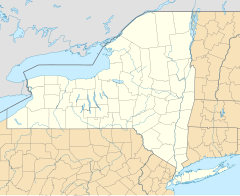Verrazano Narrows Bridge
| Verrazano–Narrows Bridge | |
|---|---|

The Verrazano–Narrows Bridge, looking toward Staten Island from Brooklyn.
|
|
| Coordinates | 40°36′23″N 74°02′44″W / 40.60639°N 74.04556°WCoordinates: 40°36′23″N 74°02′44″W / 40.60639°N 74.04556°W |
| Carries | 12 lanes (6 upper; 6 lower) of |
| Crosses | The Narrows |
| Locale | New York City (Staten Island–Brooklyn), New York, U.S. |
| Other name(s) | Verrazano Narrows Bridge, Verrazano Bridge |
| Maintained by | MTA Bridges and Tunnels |
| Characteristics | |
| Total length | 13,700 feet (4,176 m) |
| Width | 103 feet (31 m) |
| Height | 649.68 feet (198 m) |
| Longest span | 4,260 feet (1,298 m) |
| Clearance above | 15 feet (4.57 m) (upper level) 14.4 feet (4.39 m) (lower level) |
| Clearance below | 228 feet (69.5 m) at mean high water |
| History | |
| Designer | Othmar Ammann |
| Construction begin | August 13, 1959 |
| Opened | November 21, 1964 (upper level) June 28, 1969 (lower level) |
| Statistics | |
| Daily traffic | 189,962 (2008) |
| Toll | As of March 22, 2015, (westbound only) $16.00 (cash); $11.08 (New York State E-ZPass) |
The Verrazano–Narrows Bridge is a double-decked suspension bridge that connects the New York City boroughs of Staten Island and Brooklyn. It spans the Narrows, a body of water connecting the relatively protected upper bay with the larger, wide open lower bay.
The bridge is named for the Italian explorer Giovanni da Verrazzano who in 1524 became the first documented European explorer to enter New York Harbor and the Hudson River. It has a central span of 4,260 feet (1,298 m) and was the longest suspension bridge in the world at its completion in 1964, until it was surpassed by the Humber Bridge in the United Kingdom in 1981. It has the 13th longest main span in the world, and the longest in the Americas. Its towers can be seen throughout New York City and in New Jersey.
The bridge marks the gateway to New York Harbor. All ships arriving at the Port of New York and New Jersey pass underneath the bridge and must therefore be built to accommodate the clearance under it. Since 1976, the Staten Island end of the bridge has been the starting point of the New York City Marathon.
The bridge was the last great public works project in New York City overseen by Robert Moses, the New York City Parks Commissioner and head of the Triborough Bridge and Tunnel Authority. He had long desired the span as a means of completing the expressway system he had championed during his tenure. It was also the last project designed by Chief Engineer Othmar Ammann, who had designed most of the other major crossings into and within New York City, including the George Washington Bridge, the Bayonne Bridge, the Bronx Whitestone Bridge, the Triborough Bridge, and the Throgs Neck Bridge. The plans to build the bridge caused considerable controversy in the Brooklyn neighborhood of Bay Ridge, because many families had settled in homes in the area where the bridge now stands and were forced to relocate. Construction on the bridge began August 13, 1959, and the upper deck was opened on November 21, 1964, at a cost of $320 million in 1964 dollars, equivalent to $2,471 million in present dollars. Three men died building the bridge, including 58-year-old Paul Bassett and 19-year-old Gerard McKee. The latter's death became the subject of a chapter of The Bridge: The Building of the Verrazano–Narrows Bridge, a book written by Gay Talese.
...
Wikipedia



